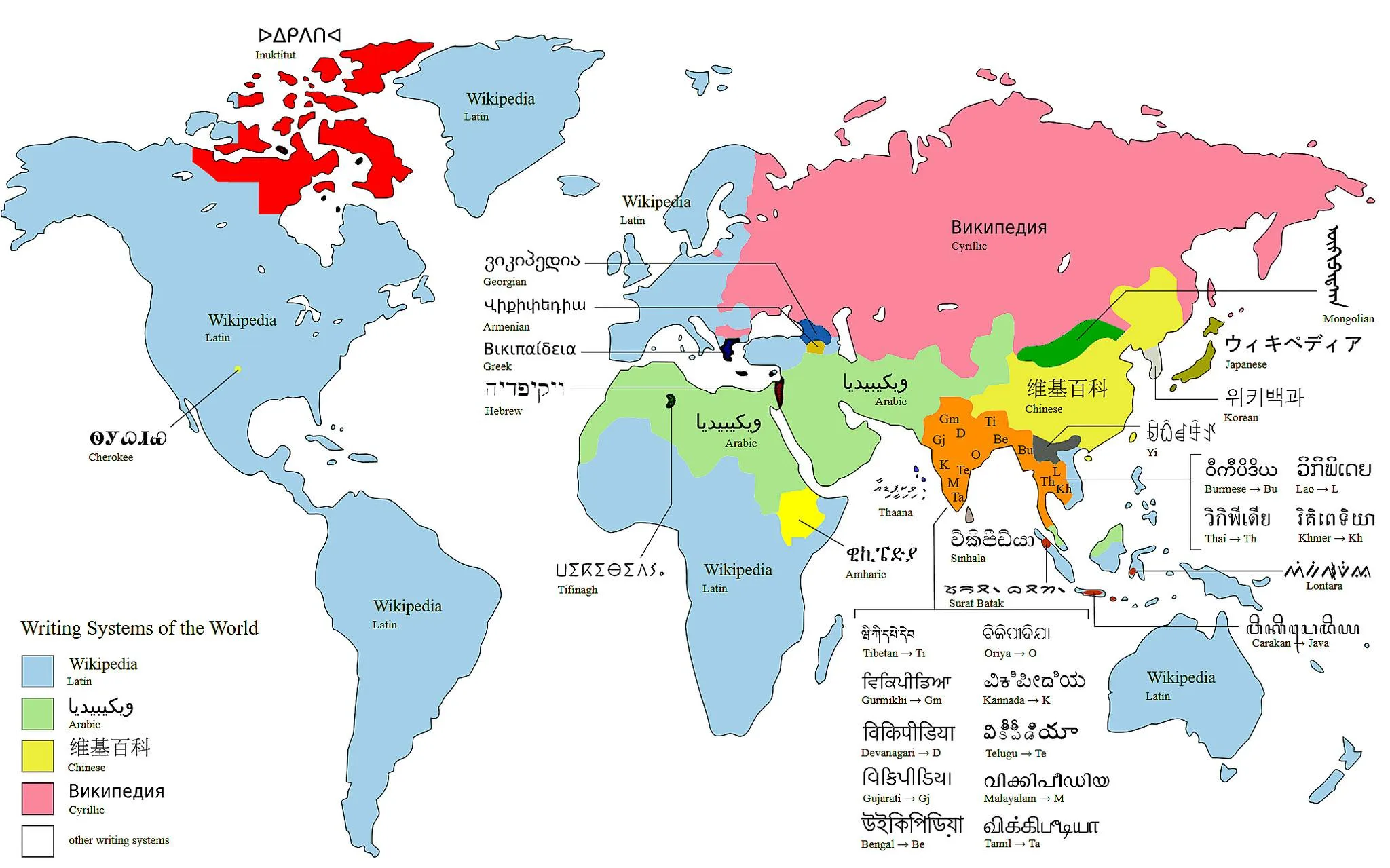 See more visualizations like this on the Voronoi app.
See more visualizations like this on the Voronoi app.
Mapped: Writing Systems of the World
See visuals like this from many other data creators on our Voronoi app. Download it for free on iOS or Android and discover incredible data-driven charts from a variety of trusted sources.
Key Takeaways
- The Latin alphabet is by far the most used writing system in the world, used by 70% of the global population.
- Other popular writing systems include Chinese (Han), Arabic, Devanagari, Cyrillic, and Bengali.
When you think of writing, you likely immediately think of the Latin alphabet.
And although this system is used by billions, there are a variety of other popular scripts that are used throughout the planet.
Today’s map comes from Wikipedia, using data from Wikipedia and Encyclopedia Britannica, and it highlights all scripts in active use by more than 50,000 people.
The Most Popular Writing Systems
Below is a list of the most popular writing systems, including the regions where they are used:
| Script | Type | Users (millions) | Main Regions |
|---|---|---|---|
| Latin | Alphabet | 4,900+ | Used worldwide for most European, American, and many Asian and African languages. |
| Chinese (Han) | Logographic | 1,541 | Used in China, Japan (Kanji), Korea (Hanja), and Singapore. |
| Arabic | Abjad / Abugida | 828 | Middle East, North Africa, Iran, Pakistan, and parts of Central and South Asia. |
| Devanagari | Abugida | 480.5 | India, Nepal, and Fiji (Hindi, Marathi, Nepali, Sanskrit, etc.). |
| Cyrillic | Alphabet | 350 | Eastern Europe, Russia, Central Asia (Slavic and Turkic languages). |
| Bengali | Abugida | 300 | Bangladesh and eastern India. |
| Kana (Hiragana & Katakana) | Syllabary | 123 | Japan (Japanese and Ryukyuan languages). |
| Telugu | Abugida | 83 | Southern India. |
| Hangul | Alphabet (Featural) | 81.7 | North and South Korea, also used by a small group in Indonesia. |
| Tamil | Abugida | 78.6 | India, Sri Lanka, Singapore, Malaysia. |
| Thai | Abugida | 70 | Thailand. |
| Gujarati | Abugida | 57.1 | Western India. |
| Kannada | Abugida | 45 | Southern India. |
| Geʽez (Ethiopic) | Abugida | 41.9 | Ethiopia and Eritrea. |
| Burmese | Abugida | 39 | Myanmar. |
| Malayalam | Abugida | 38 | Southern India. |
| Odia | Abugida | 35 | Eastern India. |
| Gurmukhi | Abugida | 33.1 | Northern India (Punjab). |
| Sinhala | Abugida | 16 | Sri Lanka. |
| Khmer | Abugida | 16 | Cambodia. |
| Greek | Alphabet | 13.5 | Greece and Cyprus. |
| Hebrew | Abjad / Alphabet | 9.3 | Israel and Jewish communities worldwide. |
| Ol Chiki | Alphabet | 7.3 | Eastern India (Santali language). |
| Lao | Abugida | 7 | Laos. |
| Tibetan | Abugida | 6.2 | Tibet, Bhutan, and northern India. |
| Armenian | Alphabet | 5.4 | Armenia and diaspora. |
| Mongolian | Alphabet | 5.2 | Mongolia and northern China. |
| Georgian | Alphabet | 3.7 | Georgia (Caucasus region). |
| Meitei (Meetei Mayek) | Abugida | 2 | Northeastern India. |
| Chakma | Abugida | 0.8 | India, Myanmar, Bangladesh. |
| Thaana | Abugida | 0.34 | Maldives. |
| Canadian Aboriginal Syllabics | Abugida | 0.07 | Northern Canada (Inuktitut and Cree languages). |
The Latin alphabet dominates and is used by nearly two-thirds of the world’s population, from English and Spanish to Vietnamese. It’s the most geographically widespread script in history, and comes from interesting origins.
In Asia, some of the world’s oldest scripts are still alive and thriving. The Chinese writing system, with roots stretching back over 3,000 years, remains central to everyday life for more than 1.5 billion people. Meanwhile, India stands out as a linguistic mosaic, home to at least eight major scripts derived from the ancient Brahmi system, each linked to a different regional language and identity.
Other writing systems reveal remarkable innovation. Hangul, the Korean alphabet, was scientifically designed in the 15th century to be easy to learn and phonetically precise, a rare case of a consciously engineered script succeeding on a national scale.
Across cultures, writing systems are more than just communication tools—they are living symbols of history, identity, and power that continue to shape how billions of people see and describe the world.
Learn More on the Voronoi App 
To learn more about this topic, see how the global literacy rate has changed over the years.















